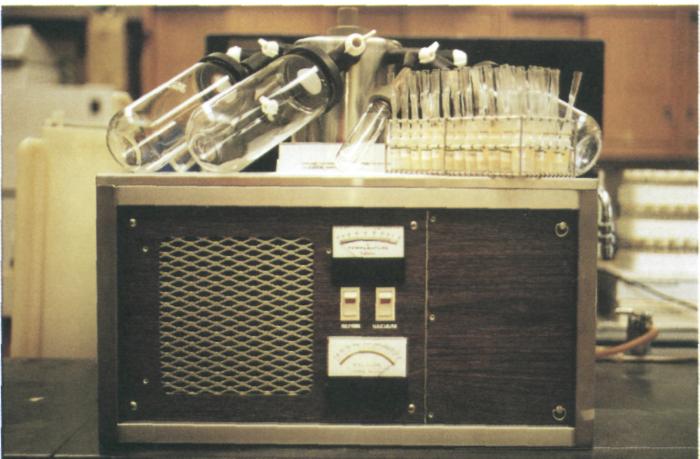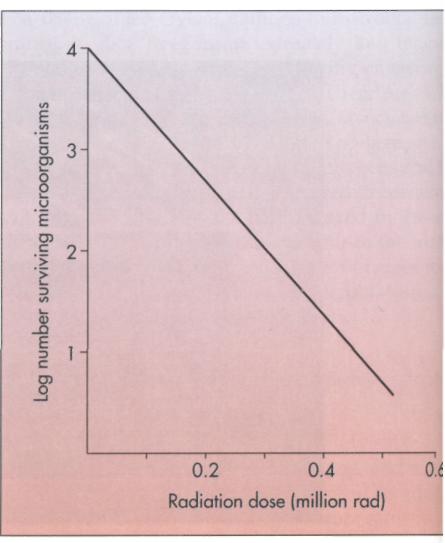
- •Control of microorgani environmental factors
- •Microbial populations can be controlled by modifying environmental conditions.
- •Ms by physical
- •Bringing Sanitary Conditions to Hospitals
- •314 Chapter 11 control of microbial growth and death
- •Sterility Testing
- •Ization process, the medium is exposed to steam at a temperature of 121° с (which corresponds to 15 pounds per square inch pressure) for 15 minutes in an autoclave.
- •Canning is a food preservation method in which suitably prepared foods are placed in glass or metal containers that are heated, exhausted, and hermetically sealed.
- •Because water is required for microbial growth, many foods can be preserved by desiccation.
- •318 Chapter 11 control of microbial growth and death
- •Ters) increases the death rate of microorganisms
- •Important pathogenic implications. Mycobacterium Therefore gamma and X-radiations are referred t
- •Tions, induces the formation or toxic free radical
- •Important pathogenic implications. Mycobacterium Therefore gamma and X-radiations are referred to as
- •, R, , „ , ,1 . I II tions, induces the formation of toxic free radicals,
- •Salem Witch Hunts
- •Ultraviolet light kills microorganisms only on or near the surface of clear solutions by disrupting their dna.
Because water is required for microbial growth, many foods can be preserved by desiccation.
Although lack of available water prevents microbial growth, it does not necessarily accelerate the death rate of microorganisms. Some microorganisms, therefore, can be preserved by drying. Active dried yeast is used for baking purposes. After the addition of water, the yeasts begin to carry out active metabolism. Freeze-drying (lyophilization) is a common means of removing water that can be used for preserving microbial cultures (FIG. 11-6). During freeze-

FIG. 11 -6 Lyophilization, or freeze-drying, is used to preserve microbial cultures. The instrument used for this process uses a high vacuum and low temperature so that water sublimes (goes from the solid frozen state directly to a gas). This removes water from the specimen without disrupting cellular structures, allowing viability to be maintained.
318 Chapter 11 control of microbial growth and death
Radiation
drying, water is removed by sublimation, that is, wa ter is converted directly from the solid to the gas High-energy, short-wavelength radiation disr phase. This process generally eliminates damage to DNA molecules. Exposure to such radiation microbial cells from the expansion of ice crystals. cause mutations, many of which are lethal. Expo
to gamma radiation (short wavelengths of 10
Lack of water prevents microbial growth but does 10-1 nanometers), X-radiation (wavelengths of
not accelerate the microbial death rate, making to 10 2 nanometers), and ultraviolet radiation (u
possible preservation by drying. violet light with wavelengths of 100 to 400 nano
Ters) increases the death rate of microorganisms
Whereas some microorganisms are relatively resis- is used in various sterilization procedures to kill
tant to drying, other microorganisms are unable to croorganisms. Gamma and X-radiation have 1
survive desiccating conditions for even a short pe penetrating power and are able to kill microorgan
riod of time. The ability to withstand drying can have isms by inducing or forming toxic free radicals (it
Important pathogenic implications. Mycobacterium Therefore gamma and X-radiations are referred t
tuberculosis is a classic example of an organism capa- ionizing radiations. Free radicals are highly reac
ble of withstanding severe desiccation and still re- chemical species that can lead to polymerization
maining infective. In contrast, Treponema pallidum, the other chemical reactions disruptive to tFte biochi
bacterium that causes syphilis, is extremely sensitive cal organization of microorganisms. Viruses
to drying and dies almost instantly in the air or on a other microorganisms are inactivated by exposui
dry surface. ionizing radiation (FIG. 11-7).
Some microorganisms produce specialized spores that can withstand the desiccating conditions of the Exposure to radiation may cause microbial mute
Tions, induces the formation or toxic free radical
atmosphere. Such spores generally have thick walls inereoses microbial death rates, and is used as
that retain moisture within the cell. Many fungal sterilization method.
spores can be transmitted over long distances
through the atmosphere; some spores even travel Sensitivities to ionizing radiation vary. Nonrq
from one continent to another. The transmission of ducing (dormant) stages of microorganisms tem
fungal spores through the air is a serious problem in be more resistant to radiation than growing on;
agriculture because it permits the spread of fungal isms. For example, endospores are more resis
diseases of plants from one field to another. than the vegetative cells of many bacterial spei

FIG. 11 -7 Ionizing radiation effectively kills microorganisms, including viruses.
318 CHAPTER 11 CONTROL OF MICROBIAL GROWTH AND DEATH Г
Radiation
drying, water is removed by sublimation, that is, wa ter is converted directly from the solid to the gas High-energy, short-wavelength radiation disrupts phase. This process generally eliminates damage to DNA molecules. Exposure to such radiation may microbial cells from the expansion of ice crystals. cause mutations, many of which are lethal. Exposure
to gamma radiation (short wavelengths of 10 3 to
Lack of water prevents microbial growth but does Ю"1 nanometers), X-radiation (wavelengths of 10 3
not accelerate the microbial death rate, making to 10 2 nanometers), and ultraviolet radiation (ultra
possible preservation by drying. violet light with wavelengths of 100 to 400 nanome ters) increases the death rate of microorganisms and
Whereas some microorganisms are relatively resis- is used in various sterilization procedures to kill mi-
tant to drying, other microorganisms are unable to croorganisms. Gamma and X-radiation have high
survive desiccating conditions for even a short pe- penetrating power and are able to kill microorgan-
riod of time. The ability to withstand drying can have isms by inducing or forming toxic free radicals (ions),
